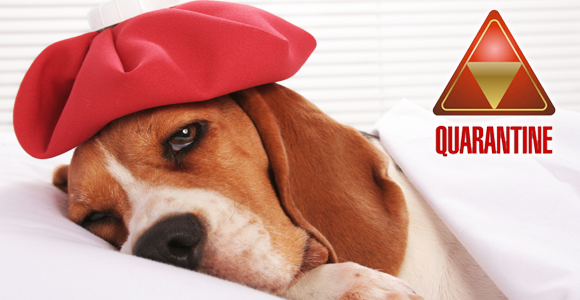One thing we are starting to hear more and more of lately is, “I rescued this dog from the pound yesterday!” And that is brilliant, because there is no shortage of dogs needing homes. However, my response to these remarks probably isn’t what most people would expect.
I immediately pull my own dog(s) away and ask the person why their dog, who is fresh out of the pound environment, isn’t in quarantine.
“What’s quarantine?” they always ask. And while it’s horrifying to find people don’t know about this very important step after adopting or rescuing a dog, how are they supposed to when most pounds or even vets do not educate the general public about it.
The quarantine period is 10-14 days (some people choose longer) where the dog that has just come from the pound is isolated from everyone and anything else. This is to stop the spread of any disease it may be carrying, especially as the pound environment can be disease central due to the amount of dogs coming through their doors.
A proper quarantine setup will consist of a concrete area, with solid brick or concrete walls (sealed), and a drain. All of this will need to be bleached every day and this area cannot be accessed by any other animals. You will need boots that you only step in as you go into the area and a tray with bleach or treating solution that you can step in when coming out of the area, before taking off the boots. The thing to remember here is you will be doing everything in your power to not spread any potential diseases.
Now, a lot of people who have adopted a dog (and even foster carers from rescue groups) do not have setups like this. But that doesn’t mean we can’t minimise the effect a new dog may have on us and others in the community. Because, while you may be okay with having your new dog mingle with your own animals, the community has not given you their permission to expose their animals to risk. So if you’re unable to set up a full quarantine area, you need to look at how you can lessen the chances of exposure.
If you have a laundry or bathroom, keep your new dog in there, away from any other animals for 10-14 days. Remember that things like Kennel Cough and (more importantly) Parvovirus can incubate during this amount of time, so there may not be any physical signs your dog is infected for a while. You will need to bleach the floors and the walls, and make sure that any bowls, toys, and bedding, do not leave that room. You’ll need a change of shoes and clothes for that room, and get ready to keep washing! Two weeks of this may seem daunting, and maybe even a little cruel for the dog, being so isolated, but there’s a few reasons why this is better in the long run.
The obvious is the spread of disease will be greatly reduced. Not just for your own animals but other peoples’ pets in the community. The second reason is that this time in isolation can give you a clearer picture of what the dog’s personality and behaviour is like. Especially if you have other dogs, these one-on-one moments give you and the new dog a chance to bond and figure each other out, without the worry of another dog being in the mix. It will also give the dog a chance to settle in, getting used to the smells and sounds of your home and its occupants, without being thrown to the sharks straight off the bat.
So please remember, if you are going to disregard all quarantine advice and risk your own pets, then that is your prerogative. But please be mindful of other people in the community, who do not want their dogs at risk. If you are transporting a dog from the pound, please take all precautions so the spread of disease can be minimised. If you are fostering a dog, and have other dogs in the house, follow the isolation advice, and give your dog time to settle, before throwing him into the mix.


